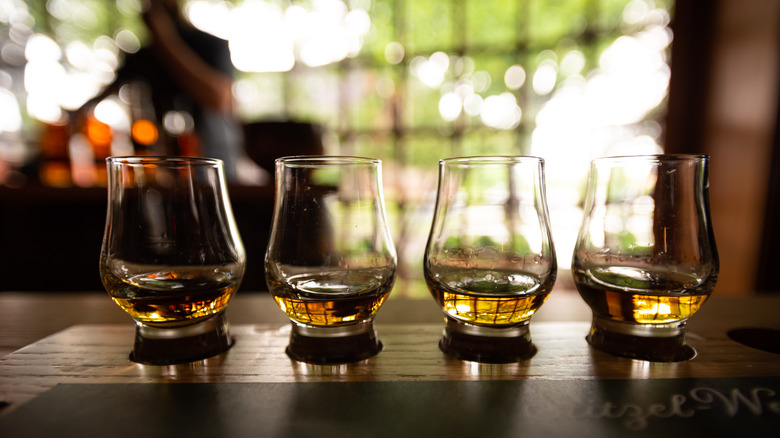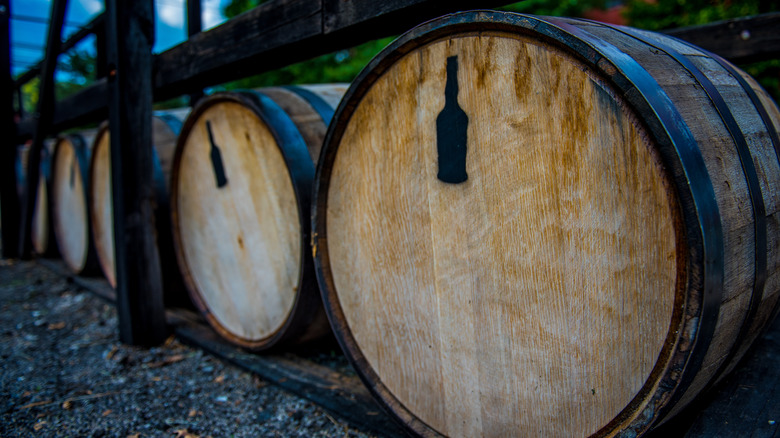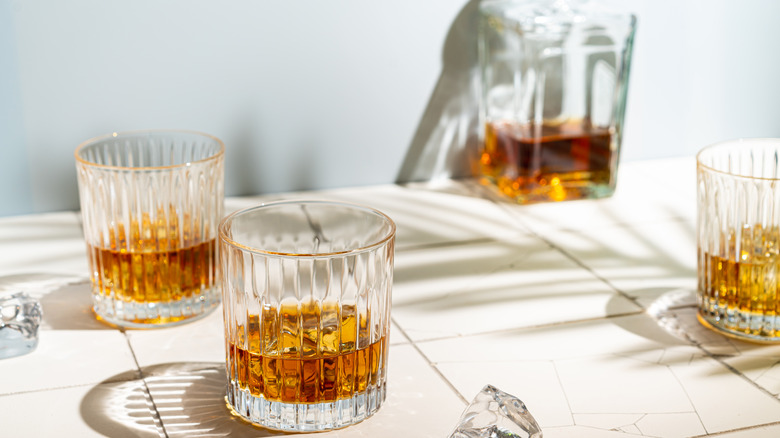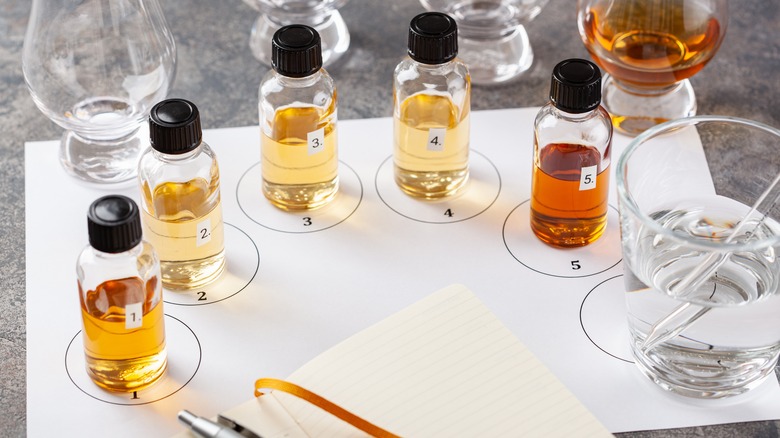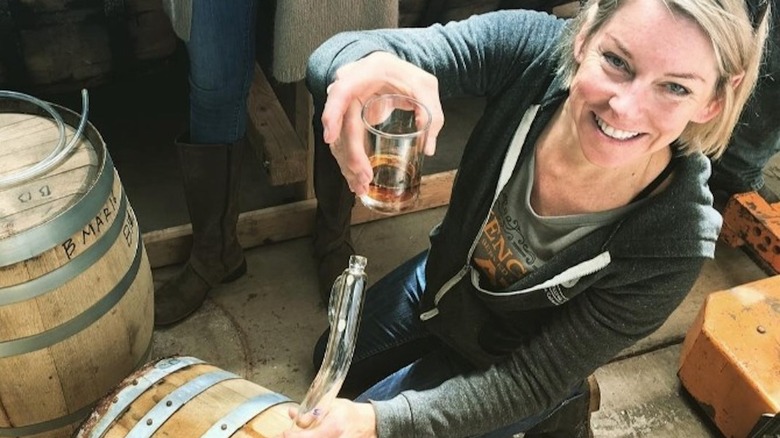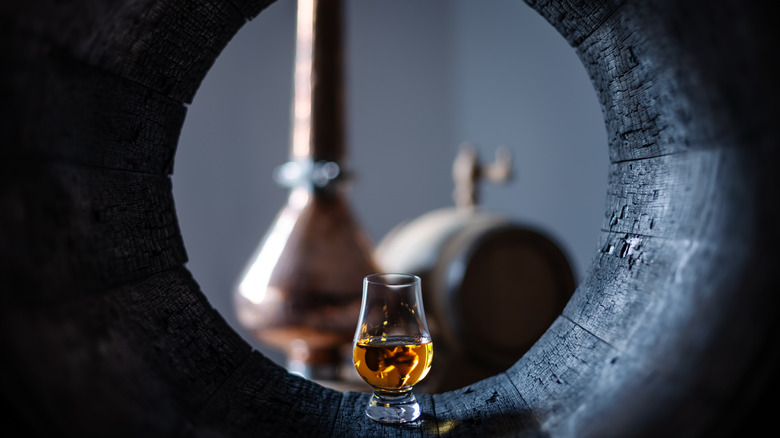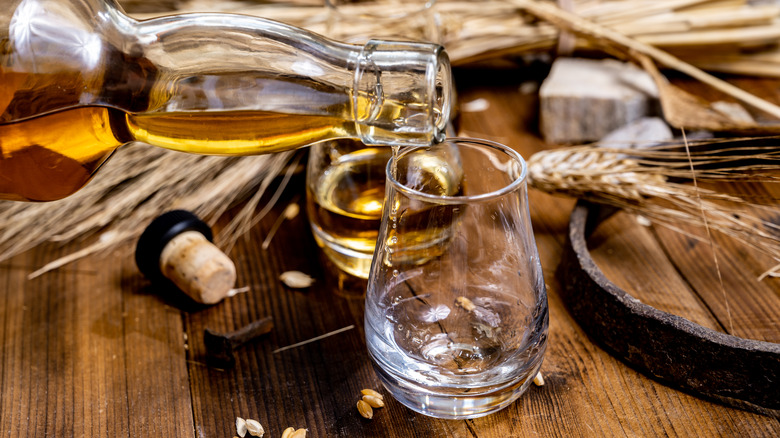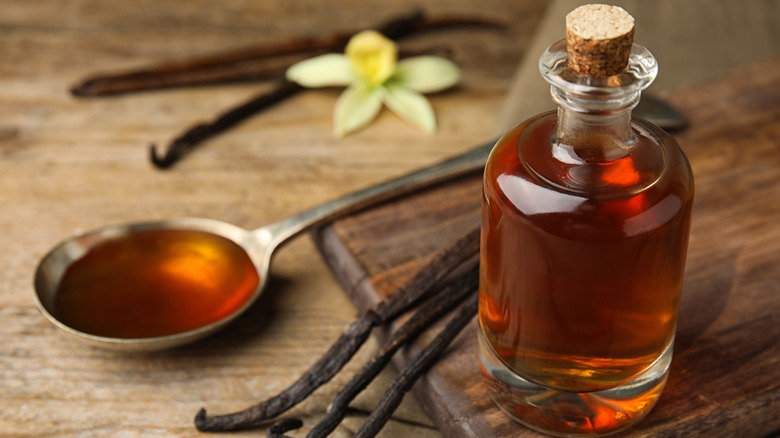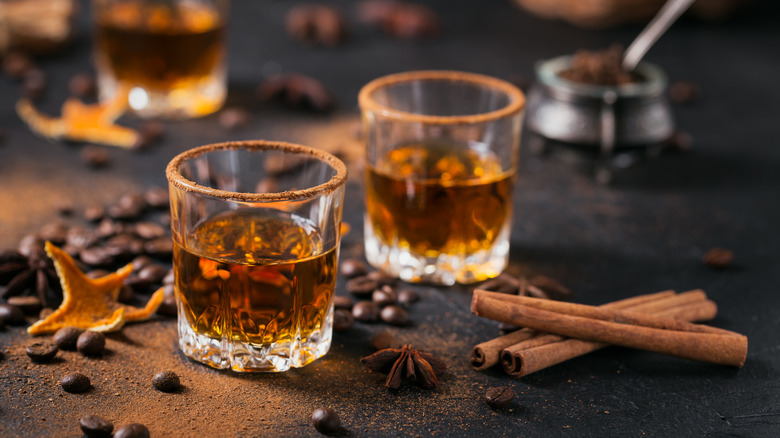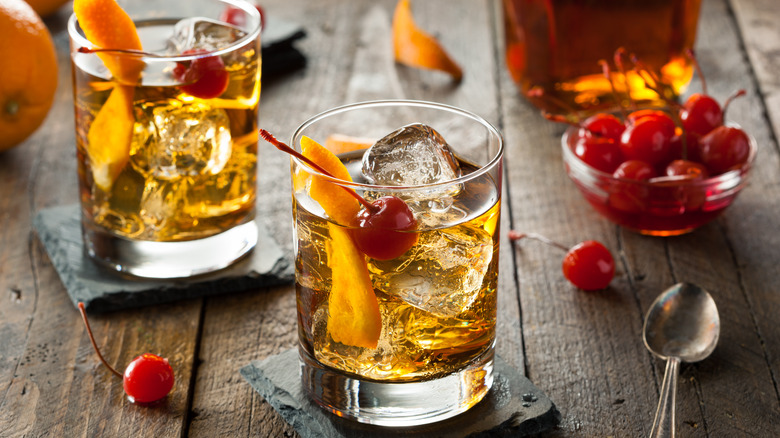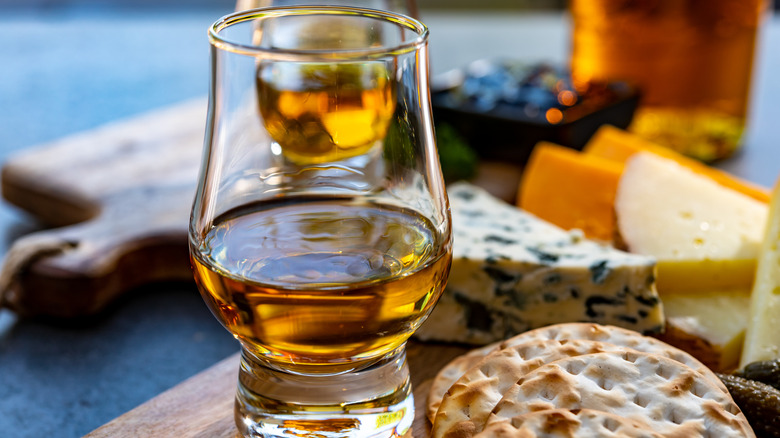Your Guide To The Official Bourbon Tasting Wheel
Few spirits right now are hotter than bourbon, but familiarizing yourself with this distinctly American beverage can be daunting. If you want to get acquainted with the Kentucky-born whiskey, it's worth exploring the bourbon tasting wheel (courtesy of the American Bourbon Association) which helps to demystify the process of tasting your way to connoisseur status by guiding your way through detecting the spirit's five major tasting categories.
But even learning the ins and outs of the wheel can prove to be a challenge, particularly for novices. That's why we enlisted the help of bourbon experts to help break it down and offer tips on how to hone the skill of sipping and sniffing as well as what to look for with entry-level bottles that are ideal for those new to the game. They also shared insights on how you can avoid beginner pitfalls and make the most of your new bourbon toolkit. Through their advice and the guidance of the wheel, you'll be well-versed in the art of bourbon tasting in no time.
The bourbon tasting wheel does not apply to other whiskies
Avoid any confusion by remembering a whiskey tasting wheel focuses on different flavor profiles than bourbon notes — the bourbon versus other whiskey difference is more than semantics. Bourbon is whiskey in the same way that a boot is a shoe but not all shoes are boots. A specific category of American whiskey, federal requirements dictate that bourbon contains at least 51% corn in its mash (grains used in the fermentation process), ages in new charred oak barrels, and is bottled at no less than 80 proof. One common misconception is that the spirit doesn't have to be made in Kentucky, only in the U.S. — so it's not exactly the Bourdeaux of the whiskey world.
Tighter regulations influence the overall flavor profile, such as the use of corn mash which lends to the whiskey's sweetness while the barrel aging adds notes of caramel and spice. Unlike other whiskies, added flavoring and colors are forbidden. In comparison, a whiskey tasting wheel looks at eight different flavor categories, while the official bourbon version focuses on just five sections. The narrower options might be good news for bourbon beginners, and, of course, the five categories are only launching points.
"Through exploration and innovation in the category, we are seeing additional expressions, new cask finishes, and alternative blending and maturation techniques being pulled from other areas of the whiskey community," says Matt Ward, the VP of brand strategy at Indiana-based Penelope Bourbon. In other words, you'll find plenty of innovative bourbons to explore.
Bourbon tasting 101: categorizing versus drinking
Similar to enjoying the complexities of wine, tasting bourbon requires learning how to savor — once the shock of the alcohol fades — to categorize potentially rolling flavors and subtle aromas versus just shooting the delicious brown liquid. You'll want to assess appearance, aroma, taste, and finish — and take plenty of notes in order to compare your experiences with different bottles.
One of the best ways to open the flavor of bourbon and help develop your tasting skills is to incorporate water. "A drop or two of water should be added after an initial taste neat, as the chemical reaction will boost the concentrations of flavor compounds and 'open' or 'release' aromatics to further explore the depth of the whiskey," says Connie Baker, the co-founder, CEO, and head distiller at Marble Distilling Co., an artisan operation known for using local grains and sustainable practices. She adds that after the initial sip of the straight spirit "a noticeable difference before and after water can help identify flavor profiles."
Unlike wine, you should be cautious about nosing the high-proof spirit. Jason Druckenmiller, the head of whiskey advocacy at Proximo Spirits which covers brands such as Great Jones and Tincup, actually advises against sticking your nose into the glass when you take a sniff: "This paralyzes olfactory senses for a few moments, so it's important to hold the glass just below your chin and slowly bring it towards your nose until you get the first aroma of the liquid," he says. Druckenmiller also recommends closing your eyes during the nosing process. "It is scientifically proven that cutting off this sense will heighten other senses," says the whiskey advocate. "It enhances the overall tasting experience, overall flavor, and aroma identification."
Start with the basics (and the center of the wheel)
The American Bourbon Association tasting wheel is setup as a guide to start with the most general notes and evolve the palate by moving into specific terminology. First, you will see that the "wheel" is a circle slicing into five focus areas: wood, grain, sweet, spice, and fruit or floral. Each category is then divided to more niche tasting notes, such as oak versus conifer or earthy versus aromatic. Whether tasting a single bourbon or a flight, it's best to start with the dominant flavors and aromas before narrowing down to more specific notes.
Beginning with the basics refers to more than just the five tasting categories. according to Ivan Papic, the beverage director of New York City restaurant Sweetbriar. He recommends avoiding overproof or aging as a beginner, then to "work your way up the bourbon ladder while developing and training your palette." Charred oak barrels impart a majority of the common tasting notes in straight bourbon, such as baking spices or vanilla, since colorings and additives aren't allowed. Additional aging means more flavor and many enthusiasts believe that 10 to 15 years of aging is a sweet spot for bourbon.
Just like alcohol can make for an intense aroma, the same can be said of the taste. Ward recommends, "If you are exploring for the first time, find a nose and palette that you like within a brand at a lower proof point and then work your way up in the higher proof points."
Upgrade to more specific (and subjective) taste descriptors
Using the wheel, you'll work your way outward to garner more specificity with the tasting notes, and this is where you can get more creative. Everyone is starting with a range of reference points and preferences. Taste spice? Likely. Specifically cinnamon? Sounds great. How about notes that evoke Christmas morning? Sure, why not?
Druckenmiller finds that you can taste the nuances based on geolocation, such as the conditions in the regions where the spirits are made and even minerals in the water. For example, Druckenmiller explains that Proximo Spirits brand Great Jones Straight Bourbon is made from 100% New York-grown corn, malted barley, and rye, so "you find a light pepper finish that comes from the black dirt soil where the grain comes from."
Discovering nuance is where bourbon tasting can really get fun. Papic finds the bourbon tasting wheel will help build vocabulary beyond first impressions. However, he clarifies that tasting is open to interpretation: "In the end, there are no wrong answers here; everyone has a different palette and some people might be tasting flavors that others do not register at all."
Wood and the all-important char
New barrels of charred oak act like seasoning to bourbon. The oak barrels are burnt, usually for up to one minute, and create chemical compounds from the sugars, tannins, cellulose, and more in the wood that are then interpreted by us in intricate ways.
The category of wood might not be the first flavor that comes to mind when sipping bourbon; however, this area on the tasting wheel includes nuts like almond or oak, whether toasted or new. Wood also includes a conifer subsection, so you might notice pine or cedar after allowing bourbon to linger on the tongue.
Although some distillers are choosing to experiment with French oak or fortified wine barrels, traditional bourbon is unique in its adherence to using only American oak. Granted, flavors do not operate in isolation. In comparison to other types of whiskey, Papic says, "I like seeing how the sweetness of corn is being affected by exposure to wood over a longer period of time."
The backbone of grain, particularly corn
Grain as a bourbon tasting category can be more complex than you might expect. Bourbon can be made from a range of different grains, as long as the mash bill contains a minimum of 51% corn. With grain, distillers are able to experiment with the ingredients of the mash bill, and Druckenmiller finds it will change the perceived sweetness, spiciness, and overall flavor profile of the whiskey. "[C]orn is naturally sweet and wheat is naturally more subtle," he says. "However, when wheat interacts with corn, it will produce a sweeter whiskey than just wheat alone."
Druckenmiller explains grain can be an easier starting point for beginners to identify. "Different grain ingredients will produce different flavors — corn, for example, creates sweet flavors, while rye grains deliver a spicy note," he says. "When it comes to flavor, grain is a fun wild card." Due to the nature of the grains, both Papic and Baker mention that grain can also be harder to pinpoint, so don't be surprised if this category requires more practice.
Looking at the bourbon tasting wheel, grains can be perceived as either sweet or spicy. Anyone who enjoys a Manhattan cocktail may be attuned to the spiciness of rye. But, can you tell the difference between a high rye and wheated bourbon? What about hints of cocoa or cereal thanks to malt? The grain additions can yield surprising results.
The sweet balance
Depending on who you ask, tasting sweetness in bourbon might seem like a given or a pleasant surprise once the alcohol mellows. This whiskey's sweet profile is one of the more nuanced and can be an excellent starting point for tasting beginners. We've always appreciated the sweeter notes of bourbon compared to a heavily peated whiskey (don't come for us).
When we asked Baker what tasting category is the most approachable, her answer was simple: Sweet. "So often people will say they are tasting caramel popcorn, which can be the first 'comparison' they may draw," she says. The head distiller finds that the bourbon's mash bill of over 50% corn results in "a sweetness that shines on the initial sip more so than other whiskies."
The tasting wheel breaks sweet notes into buttery, candy, or baked segments. The buttery notes of vanilla, caramel, and maple syrup are the direct result of the reactions of the sugars when the oak barrels are charred, such as vanilla from the vanillin released during the breakdown of the wood. For many drinkers, sweet not only offers a simple touchstone but can include a moment of nostalgia. Clinging to a hint of butterscotch in your bourbon that reminds you of grandma? We hear you. After all, isn't liquor just candy for grownups?
A lingering spice
Detecting spice in bourbon is another umbrella category with incredible nuance and subjectivity. The segment is split into aromatic and earthy subcategories, which are further divided into flavors such as tobacco, licorice, clove, herbal tea, black pepper, or leather. Many of the tasting notes seem like everyday flavors, and determining which is apparent over the other in a spirit could require a bit of practice.
Papic of Sweetbriar mentions the influence of spice (along with wood and grain) "is a little more complicated since most novice drinkers might be meeting with those flavor profiles for the first time and it could be sometimes very hard to describe what they actually taste."
Multiple factors in the mash bill and distillation process can create spice in the final product. Druckenmiller explains that "spice will always be introduced through the wood and, in some cases, the grain (i.e. rye)." The level of spice will depend on the bottle, so it's a nuance that needs time to develop.
The harmony of fruit & floral
Fruit and floral notes on the bourbon tasting wheel might be overwhelming at first. The subcategories of fruit are plentiful. Can you confidently verify peach versus apricot? How about stewed apples versus fresh? The good news is that you likely have more experience with these aromas and flavors than you realize.
"In my opinion, sweetness and fruit/floral notes is something that is easier to notice and describe by novice Bourbon drinkers," says Papic. He finds that the flavors are so ubiquitous that many of us have already been exposed to items like citrus, blueberries, and rose, making it easier to talk about and pinpoint the fruit or floral notes in a bourbon.
The notes might be simple, but the inclusion comes down to a science. Alcohol from the liquor will also start to react with fatty acids from the wood and create esters, such as ethyl acetate (what we perceive as a sweet and fruity aroma), according to Tales of the Cocktail Foundation. So, you call it raspberry but they call it ethyl acetate? All the same, it's an approachable category worth exploring.
Test your tasting skills with value-driven bourbon
Once you learn the ins and outs of the bourbon tasting wheel, it's time to get sipping. We recommend starting with bourbons under $50 (no need to chase after the allocated bottles), though it doesn't always come down to just price. "Try Kentucky versus Texas versus Colorado, etc.," says Baker. "See if you notice the terrior difference. It exists." She should know as a small-batch bourbon distiller of whiskey which includes four Colorado-grown grains filtered through crushed, calcite Yule marble from a nearby quarry. (Talk about terrior!) Druckenmiller notes that low-proof bourbon-style whiskies can quickly graduate. He recommends experimenting with a bottle that "packs more of a punch" and will "give a more intense mouthfeel without burning or overwhelming the palate."
But before you start reaching for the deep cuts, you might want to play it safe as you begin to get familiar with bourbon. Papic explains that "diving into stuff that is aged for too long or comes at higher alcohol content might turn you away from the whole category, especially if you are a novice bourbon drinker." He adds that even experienced imbibers have a lot more to discover. "It is never too late to learn new things and further develop your palette," he says, "especially nowadays when any bar you might walk in is going to have a variety of different bourbons for you to explore."
